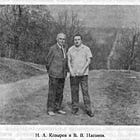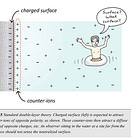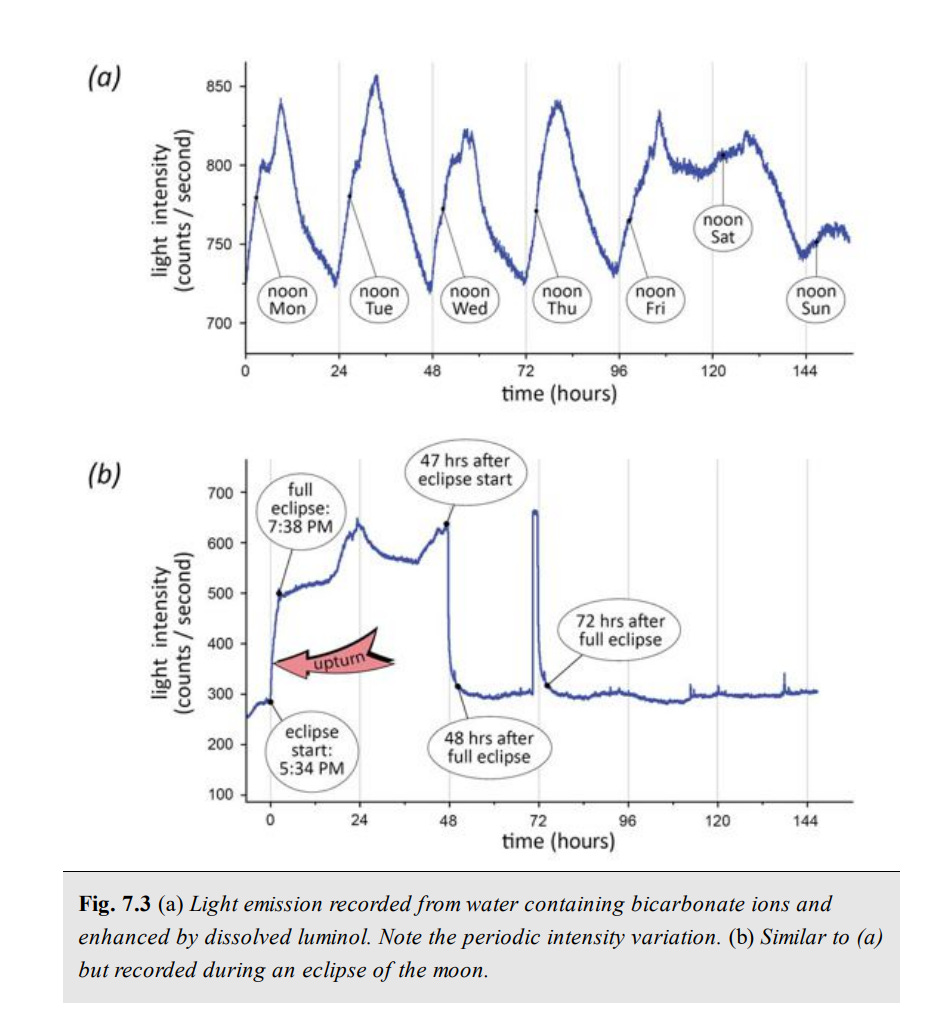Water World Part 2: Parallels between Kozyrev's and Pollack's theories and experimental observations
In this post, I am going to point to similarities in experimental observations of Kozyrev and Pollak, working in seemingly different areas of science (astrophysics and water, respectively) and many decades apart. Both have experimentally demonstrated that the Moon has a non-electromagnetic connection with the Earth. This points to some fundamental properties of our World, and the crucial role of water.
Nikolai A. Kozyrev (1908–1983) was a Russian astrophysicist who proposed the model of physics that takes into account asymmetry of the World due to the directional flow of time. He proposed that the stars, including the Sun are not thermonuclear reactors (as the establishment science claims), but rather machines that convert the energy of time into radiant energy. I discussed his work and life in these posts:
Briefly, in his 1958 paper N.A. Kozyrev (pdf in Russian) pointed at the fundamental flaws of Newton’s 2nd law of thermodynamics (and the 1st law, too), which disregard the asymmetry of time and the inherent, directly observable asymmetry of our World. He pointed to the fact that the natural world, including the stars, has no signs of undergoing thermodynamic decay. One of Kozyrev’s almost poetical statements is that the accepted theory of physics presumes the world should collapse and die a thermodynamic death, but Nature defies this theory and “sparkles afresh, renewed each morning.” Kozyrev spoke of the obvious direction and the flow of time that all of us experience as the underlying power driving the World and everything in it, counteracting forces of entropy. He proposed a "causal" or "asymmetric" model of mechanics, arguing that time possesses a directional property ("flow") that distinguishes the living World from what the dictates of the mainstream mechanical models (Newton, Einstein and quantum).
Kozyrev examined discrepancies in then available astrophysical data, specifically the longevity of stars and the lack of observed thermal death that would be expected had Newtonian laws of thermodynamics were proven true when applied to nature, as opposed to the machines. He proposed that time can perform work and generate energy.
The most profound implication of Kozyrev’s model is that the World has absolute, objectively identifiable and directly measurable cause-effect relationships, all the way back to the prime Cause of everything.
Gerald Pollack is a contemporary scientist from Washington state. His research focus is water, and specifically what he proposed as the “4th phase” of it - water’s inherent asymmetry and ability to separate positive and negative charges, creating an ice-like but non-rigid “exclusion zone” next to hydrophilic surfaces. I summarized his theory in this post:
Pollak’s research was motivated by similarly to Kozyrev’s, i.e. being dissatisfied with the mainstream physics and chemistry that do not explain the obvious asymmetry in nature and its inherent lack of physical equilibrium:
Hence, the presumption of equilibrium in classical theory conflicts with the evidence that water is out of equilibrium.
Early experiments by Piccardi: In his book Pollak described a long term series of experiments conducted by an Italian chemist Piccardi over several decades before and after WWII. Piccardi’s experiments demonstrated that, contrary to accepted theories, same chemical reactions had varying reaction times on different days, and that the variability must be mediated by water as the common element across all reactions:
Piccardi noticed, however, that the mean values of the reaction times depended on whether the samples had been shielded or unshielded [by Faraday cage]. The difference was consistent. This led Piccardi to conclude that, beyond local and known variables, some feature of the environment must influence the reaction rates. And, because those differences showed up consistently for the several different reaction types, the scientists concluded that the environmental influence had to be general. Piccardi further concluded that water had to be involved. Since water was the only common element among the diverse reactants, it appeared to Piccardi that the water must have absorbed some kind of environmental energy, which then influenced the reaction times. Although the nature of that environmental energy never became clear, the researchers found tantalizing clues for its origin. They observed repeating cycles. From December through January each year, the degree of variation in reaction times sharply dipped, but then began to increase around March, reaching a maximum during June and July. The same cycle repeated each year. They also noted other recurring phenomena. For example, reaction times varied with the natural periodicities of solar activity, and especially with sunspots and solar flares — clearly implying that the sun’s energy played a role.
Following systematic analysis with extensive controls, Piccardi concluded that the only plausible explanation was that the radiant energy absorbed by the water must have played a role in these reactions. As incident energy varied, so did the reaction times. The cycle periods were pivotal: they implied that the energy could come from the sun and possibly also from the cosmic background of space.
Pollak - Voeikov experiments: Pollak’s draws a parallel between older findings by Piccaridi and those of his colleague, Vladimir Voeikov, who conducted experiments that suggest a lunar eclipse can impact the light emitted from aqueous solutions. His research involved studying the light emitted from aqueous solutions, where he typically observed the intensity of this emitted light to oscillate with the daily cycle. However, in one instance, a sharp upward inflection in the light emission curve coincided precisely with the onset of a local lunar eclipse.
This observation led Voeikov to conclude that cosmic energy could influence the water's light output, with the effect being strong enough to override the usual daily oscillation. Further analysis of the curve revealed a modest downward recovery 24 hours after the eclipse, a sharper recovery at 48 hours, and another distinct downturn at 72 hours. The consistent occurrence of these transients at 24-hour multiples after the eclipse was deemed unlikely to be coincidental. These findings collectively suggest that incident radiation from a cosmic source appears to affect water.
In Figure 7.3b, note the sharp upward inflection near the beginning of the curve. Suspecting some experimental fluke, Voeikov checked and found that the upturn coincided exactly with the onset of a local lunar eclipse; this suggested that cosmic energy could impact the light output. That cosmic impact was evidently strong enough to overshadow the daily oscillation.
These experimental results offer a tantalizing similarity with Kozyrev’s detection of lunar eclipses via his mirror devices measuring what he termed “the flow of time”, or rather, shielding of this flow by the Moon. Like Voeikov, Kozyrev reported that mirror-based detectors registered distinct, non-electromagnetic anomalies at the moments of lunar eclipses.
Kozyrev used concave aluminum or glass mirrors to “focus” or concentrate what he called physical “energies of time”. Sensitive detectors (often thermistors, galvanometers, or photoelectric devices) were placed at the focal point. The system was shielded to reduce ordinary electromagnetic and thermal noise. He reported that, during lunar eclipses, his detectors showed sudden anomalous signals (needle deflections, thermal fluctuations) that could not be explained by ordinary light, heat, or gravitational effects. These anomalies appeared at the exact moments of astronomical alignments, such as the Moon entering Earth’s shadow.
Kozyrev emphasized that these detector responses occurred even when the Moon was optically invisible (cloud cover or below the horizon), suggesting to him that the effect was not due to ordinary light or radiation. He interpreted this as evidence of a direct causal connection through “time flow” or torsion fields, which he hypothesized to be a fundamental physical reality.
Pollak-Voeikov, as well as earlier work by Piccardi demonstrate the same “action at distance” as did Kozyrev and propose that water mediates this unknown energy.
Perhaps, these results suggest that the living World derives the entropy-defying energy from Time flowing through Water? These ideas will be explored further in my upcoming posts.
Art for today: Early fall in Napa, watercolor, 9x12 in.







Great post, Sasha... Light is important here, too. All living cells emit biophotons that are coherent (think about that one!). All of these things - water, light, gravity, time work in harmony/synchrony to create life and reality that we experience in ways that we still do not understand... Wonderfully and fearfully made.
Fascinating discourse Sasha. I had occasion recently to counsel a friend who has become increasingly agitated, and somewhat distracted, over the apparent freedom the cartel miscreants have taken in abusing the truth with impunity these days. He reportedly was feeling much better after we enjoyed an animated conversation about light and water, and added sound, with both of us sensing that full comprehension of the depth of what we were discussing was still beyond our current reach. Both of us know innately the connection of these physical elements to Creation, God's design, yet we are simply unable to fully articulate those precepts in detail... at this time. I sense some very important dots are being connected by your work Sasha. Thank you.